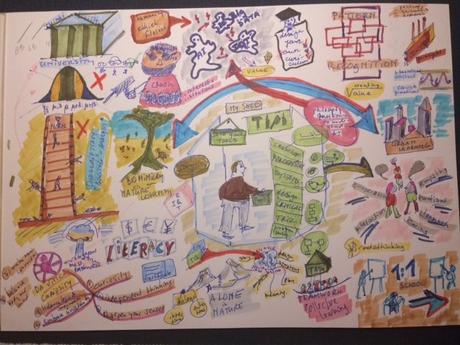In " Education - 21 Century Challenges" about "What should we teach children?"we posed two additional questions:
What advice should young people follow?
Who or where should they turn for advice when adults' wisdom may only be outdated biases?
We suggested two (visual) approaches; one that departs from the current situation and one that departs from 2050. We will begin with the latter, and soon we will present our efforts regarding the first approach: Your Face as a Student 2018
I am often found in The Meta Thinking Cave, where I carefully store my thinking tools in different drawers: one for critical-rational thinking, another for design thinking, yet another for creative thinking tools. Often I practice collaborative thinking, learning about empathy, teamwork, caring, listening, etc. My grandmother says that in her time it was called social skills.
I will have to survive in a world that is dominated by inscrutable spirits: Artificial Intelligence, The Internet of Things and Big Data. The world manifests itself to me as magically realistic. Most things around me I don't understand at all, and there is no one who can really explain it to me. So, many times I think that dead things can think, speak and listen. Sometimes, that is comforting but otherwise, it is quite threating because I begin to believe it.In order to keep a little hold on life, my shed also has a number of philosophical questioning techniques in addition to systems thinking to determine what can be true and what can be good. Incidentally, at my university, they have just introduced two mandatory courses: Context and Biases in Algorithmic Decision Making and Technology and Humanity. That is, they used to call that a university. You had to jump through a number of standardized hoops with minimal effort and then you got a "diploma".

Happily, the medieval concept of totalitarian institutions for mass instruction, which was aimed at producing one Nobel prize winner and made everyone else a drop-out and looser, is slowly fading away. Cohorts, averages and standard deviations almost no longer exist. In society, there is now a colour chart of disciplines, skills, knowledge.
That was also highly necessary. IoT, Big Data and AI have made most jobs superfluous, and everyone is looking for a good time and a reasonable income. There is a great demand for a certificate "Financial Literacy" that gives you a number of advantages from the state, but above all protects you from the pitfall of poverty. In the elderly, I noticed that they are weak in recognizing thought patterns and have difficulties in rapid switching between the abstract/conceptual and the practical/concrete. I have also been working on "Creating Value" for three months now to find out how I can counteract the boredom, now that everything and everyone around me is being AI-ed away. The first six weeks was a project called Urban Learning, I had to create with a team something of value in the city . . . Later we went into nature to learn how nature learns. When I was about eight years old, my father every night readme "Biomimicry for Children" by Asa Jomard.I have glued to it for a week "Balancing Inner Time and Outer Time", to learn not to go into all external stimuli, but also to think about my own contribution and influence. I mean, in the past you were supposed to take your place in society, but that is no longer there. Now it's time to form society myself, so I also have a certificate in Reverse AI Engineering to find out how a machine has learned and makes decisions. To be able to redesign it. But first, another week in the mountains, to rely entirely on me. Well, it's also a kind of relaxing trip and not to be busy with my own development.
You may think that I am in my twenties but this is already my eighth reorientation.
In the next post we will explore the second approach, taking the entry point from the current situation. Finally, we will confront both explorations to learn about what contradictions we will face.
